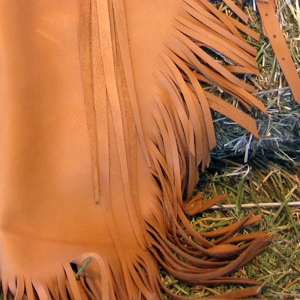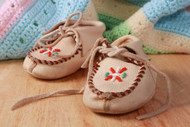Leather Moccasin Care
Posted by Daniel Sutton on Nov 13th 2014
Buckskin's had a colorful reputation over the years. Adorning most every frontier hero from Buffalo Bill to Pocahontas, this iconic hide's impact is difficult to exaggerate. There's good reason for this. For ages buckskin was the go-to hide for clothing and fabric that could endure the rugged and unpredictable terrain of the great American Frontier. This wasn't just because deer were so plentiful either. Deer were migratory animals, which meant they traveled whenever resources in a particular area started to run low - much like many Native American tribes. During this travel, deer needed sturdy hides that could push them through bark and bramble and the like, and a light, flexible skin permitting them a range of motions to outmaneuver predators. Because of the many advantages a skin like this afforded people who lived on the move, it became a very inherent element to Native American lifestyle. Its popularity persists even to this day, and not only because it's practical. It's pretty spanking fashionable too.
So fashionable, in fact, that George Washington actually had them made in bulk as official uniforms for Revolutionaries, and prior to that, encouraged buckskin-clad huntsmen to lead the English colonies' defenses, rather than the boys in red. If they couldn't have the Indians on their side, they'd have the next best thing. It worked pretty well, too. Washington won 2 out of 2 games with his magic jersey, so I'm going to check "instantaneous mastery of colonial era warfare" off on our bonus features for leather buckskin.
But let's not get carried away. Buckskin wasn't the only thing wild in the west. After deer were hunted to a fraction of their former number during the "let's kill as many buffalo as we possibly can" phase of adolescent frontiersmen, many Native Americans had to rely on other resources to make a living. Today you can find classic frontier garb made from many different animals, including cows, sheep, elk - and especially the raccoon.
Perhaps the most lasting monument to frontier culture is the moccasin. It's our topic of the day, yo.
Snappy Dressing
While buckskin apparel gradually lost favor with Native Americans in the advent of warmer and more weatherproof textiles from overseas, the moccasins are one thing that never really fell out of style. Back then, a lot of people were actually going around barefoot, partly because shoes weren't as readily available as they are today, and partly because - hey - they're pretty comfortable. Turns out, deerskin still had that same level of comfort while offering some nice protection against prickly plant and bark things on the ground. It was as popular as a Nike back in the day; a common sight for men and women alike.
That's probably the best thing about buckskin, actually: its softness. You'll be hard pressed to find anything with a gentler, delicate touch than buckskin. The unique nap (short, fuzzy fibers) feels as gentle as a doe in real life and lighter than air, as if it's not even on your foot at all. In fact, as you wear it, deerskin has an interesting ability to mold to the shape of your body. Due to its natural resistance against tear and abrasion, it also has an uncanny aptitude for making killer leather gloves. If you find a pair of buckskin leather gloves in the store, buy the heck out of those things and then some more.
That said, while buckskin requires virtually no maintenance other than an occasional cleaning to keep in shape (we're talking an average lifespan of sixty years here, give or take) it won't have much resistance to the elements. While deer were alive, they possessed natural oils in their skin and fluff to ward bad stuff off. That's all gone now. Instead, the hide strongly resembles suede, which is a very unorthodox kind of leather. Let me break things down for you.
A Doe's Touch
Suede and deerskin are both leathers that have a very slender, porous make. Due to the fine nap, oils and staining materials can have very nasty effects. The receptive nature of the hide is such that liquids can enter in very quickly, and once they do, they are difficult to remove. Efforts to condition or protect the leather will often spoil the fine nap, which largely ruins the point of owning suede. So it's a good thing you don't have to condition buckskin anyway.
You will need to clean them. Start by removing the liner if you have one. The usual deal with suede is that it needs to be brushed in one direction, a lot like a cat. If the nap has a natural flow or direction, brush it that way with a suede brush. If you are trying to pick up a stain, you can brush gently in multiple directions using a damp cloth or sponge, or a good suede cleaner. Afterwards, brush the nap back in its natural direction and allow the moccasins to dry in a cool, clean place away from sunlight and direct heat. It's also good practice to stuff them with newspapers or packing paper while they dry - similar to the leaves and deer hair trick. Certain types of paper are very absorbent, and can pull water out of leather quickly. It's a good idea to store leather in a similar manner, using more newspaper or a shoe tree to keep its structural integrity in shape.
Wilderness Survival
After your moccasins have dried, it's also a good idea to apply a suede protector. This won't be like an ordinary leather conditioner - this is merely to protect suede at the surface, and will help keep liquids from absorbing once they spill. You'll usually find suede protectors in spray form - give the leather just a light, even spray across the surface. Make very sure that your moccasins are completely dry first, or else that trapped moisture will begin to rot away your moccasins from the inside.
If you are in an area where water may be plentiful, it's a good idea to wear them indoors or use a suede leather protector on them first. You'll usually find this in spray form: just give the moccasins a light, even coat across the surface. Water should then bead and run off, rather than absorb. If you've ever wondered what those long, thin strips on the fringes of buckskin leather are for, they actually help to keep your buckskin weatherproof. As water makes contact with your leather, these strips give water a natural outlet to run down and drip off your moccasins, rather than fully absorb.

Many moccasins also have very soft tufts of fur. You won't clean these like you would the leather. Instead, use a spray bottle to lightly damp the fluff, and set a blow dryer against it around six feet away. Make sure you are careful to keep the line of heat off of the leather, as heat tends to shrink hides. Lightly fluff out fur as you go along. Also, don't put these things in the dryer. I had a stuffed animal squirrel back in the day as a kid with authentic squirrel fluff. Didn't survive very well through a wash and dry cycle. Don't make the same mistakes I did.
Bang for the Buck
Those are the basics. If you need further help caring for your moccasins, check out our Nubuck & Suede guide. Or, if your moccasins are made from conventional cowhide, they'll need different kinds of treatment. Check out our blog "How Does Leather Breathe?" for starters on that. Thanks for reading!
Contributors
Daniel Sutton
University of Virginia
Minnesota Moccasin
Braintan.com

